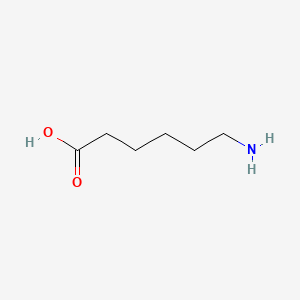| MeSH term | MeSH ID | Detail |
|---|---|---|
| Laryngeal Edema | D007819 | 1 associated lipids |
| Ludwig's Angina | D008158 | 1 associated lipids |
| Hemoptysis | D006469 | 1 associated lipids |
| von Willebrand Disease, Type 1 | D056725 | 1 associated lipids |
| Hyphema | D006988 | 1 associated lipids |
| Neoplasms, Fibrous Tissue | D018218 | 1 associated lipids |
| Eye Hemorrhage | D005130 | 1 associated lipids |
| Urethral Neoplasms | D014523 | 1 associated lipids |
| Oral Hemorrhage | D006472 | 1 associated lipids |
| von Willebrand Disease, Type 2 | D056728 | 1 associated lipids |
6-aminohexanoic acid
6-aminohexanoic acid is a lipid of Fatty Acyls (FA) class. 6-aminohexanoic acid is associated with abnormalities such as Blood Clot, Myocardial Infarction, Cerebrovascular accident, Renal impairment and Scoliosis, unspecified. The involved functions are known as Fibrinolysis, Agent, Hemorrhage, plasminogen activation and inhibitors. 6-aminohexanoic acid often locates in Chest, Blood, Body tissue, peritoneal and Plasma membrane. The associated genes with 6-aminohexanoic acid are P4HTM gene, BSND gene, MTPN gene, NDUFS4 gene and Homologous Gene. The related lipids are Phosphatidylserines and Butyric Acid.
Cross Reference
Introduction
To understand associated biological information of 6-aminohexanoic acid, we collected biological information of abnormalities, associated pathways, cellular/molecular locations, biological functions, related genes/proteins, lipids and common seen animal/experimental models with organized paragraphs from literatures.
What diseases are associated with 6-aminohexanoic acid?
6-aminohexanoic acid is suspected in Cerebrovascular accident, Blood Clot, Myocardial Infarction, Renal impairment, Thromboembolism, Postoperative myocardial infarction and other diseases in descending order of the highest number of associated sentences.
Related references are mostly published in these journals:
| Disease | Cross reference | Weighted score | Related literature |
|---|
Possible diseases from mapped MeSH terms on references
We collected disease MeSH terms mapped to the references associated with 6-aminohexanoic acid
PubChem Associated disorders and diseases
What pathways are associated with 6-aminohexanoic acid
There are no associated biomedical information in the current reference collection.
PubChem Biomolecular Interactions and Pathways
Link to PubChem Biomolecular Interactions and PathwaysWhat cellular locations are associated with 6-aminohexanoic acid?
Visualization in cellular structure
Associated locations are in red color. Not associated locations are in black.
Related references are published most in these journals:
| Location | Cross reference | Weighted score | Related literatures |
|---|
What functions are associated with 6-aminohexanoic acid?
Related references are published most in these journals:
| Function | Cross reference | Weighted score | Related literatures |
|---|
What lipids are associated with 6-aminohexanoic acid?
Related references are published most in these journals:
| Lipid concept | Cross reference | Weighted score | Related literatures |
|---|
What genes are associated with 6-aminohexanoic acid?
Related references are published most in these journals:
| Gene | Cross reference | Weighted score | Related literatures |
|---|
What common seen animal models are associated with 6-aminohexanoic acid?
There are no associated biomedical information in the current reference collection.
NCBI Entrez Crosslinks
All references with 6-aminohexanoic acid
Download all related citations| Authors | Title | Published | Journal | PubMed Link |
|---|---|---|---|---|
| Ferrari E et al. | Assembly of protein building blocks using a short synthetic peptide. | 2012 | Bioconjug. Chem. | pmid:22299630 |
| Kutikhin AG et al. | The role of calcifying nanoparticles in biology and medicine. | 2012 | Int J Nanomedicine | pmid:22287843 |
| Jang B et al. | Peptidylarginine deiminase modulates the physiological roles of enolase via citrullination: links between altered multifunction of enolase and neurodegenerative diseases. | 2012 | Biochem. J. | pmid:22551201 |
| Lee U et al. | ε-Acetamidocaproic acid pharmacokinetics in rats with gastric ulcer or small bowel inflammation. | 2012 | Xenobiotica | pmid:21992030 |
| Heimrich M et al. | Cyclic oligomers in polyamide for food contact material: quantification by HPLC-CLND and single-substance calibration. | 2012 | Food Addit Contam Part A Chem Anal Control Expo Risk Assess | pmid:22329416 |
| Ramakanth I and Patnaik A | Novel two-component gels of cetylpyridinium chloride and the bola-amphiphile 6-amino caproic acid: phase evolution and mechanism of gel formation. | 2012 | J Phys Chem B | pmid:22313448 |
| Basta MN et al. | A systematic review of the use of antifibrinolytic agents in pediatric surgery and implications for craniofacial use. | 2012 | Pediatr. Surg. Int. | pmid:22940882 |
| Lecker I et al. | Tranexamic acid concentrations associated with human seizures inhibit glycine receptors. | 2012 | J. Clin. Invest. | pmid:23187124 |
| Ahn CM et al. | Decreased lung hyaluronan in a model of ARDS in the rat: effect of an inhibitor of leukocyte elastase. | 2012 | Ups. J. Med. Sci. | pmid:22283425 |
| Holmes D et al. | All-Trans Retinoic Acid-Induced Pseudotumor Cerebri during Induction Therapy for Acute Promyelocytic Leukemia: A Case Report and Literature Review. | 2012 | Case Rep Oncol Med | pmid:22701192 |
